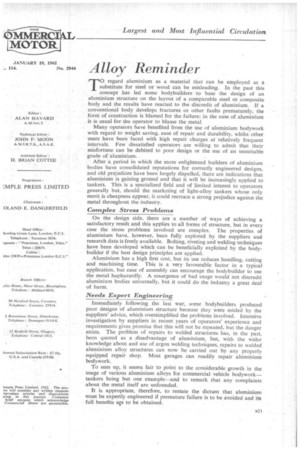Alloy Reminder
Page 27

If you've noticed an error in this article please click here to report it so we can fix it.
TO regard aluminium as a material that can be employed as a substitute for steel or wood can be misleading. In the past this concept has led some bodybuilders to base the design of an aluminium structure on the layout of a comparable steel or composite body and the results have reacted to the discredit of aluminium. If a conventional body develops fractures or other faults prematurely, the form of construction is blamed for the failure; in the case of aluminium it is usual for the operator to blame the metal Many operators have benefited from the use of aluminium bodywork with regard to weight saving, ease of repair and durability, whilst other users have been faced with high repair charges at relatively frequent intervals. Few dissatisfied operators are willing to admit that their misfortune can be debited to poor design or the use of an unsuitable grade of aluminium. , After a, period in which the more enlightened builders of aluminium bodies have consolidated reputations for correctly engineered designs, and old prejudices have been largely dispelled, there are indications that aluminium is gaining ground and that it will be increasingly applied to tankers. This is a specialized field and of limited interest to operators generally but, should the marketing of light-alloy tankers whose only merit is cheapness appear, it could recreate a strong prejudice against the metal throughout the industry.
Complex Stress Problems On the design side, there are a number of ways of achieving a satisfactory result and this applies to all forms of structure, but in every case the stress problems involved are complex. The properties of aluminium have, however, been fully explored by the suppliers and research data is freely available. Bolting, riveting and welding techniques have been developed which can be beneficially exploited by the bodybuilder if the best design principles are applied.
Aluminium has a high first cost, but its use reduces handling, cutting and machining time. This is a very favourable factor in a typical application, but ease of assembly can encourage the bodybuilder to use the metal haphazardly. A resurgence of bad usage would not discredit aluminium bodies universally, but it could do the industry a great deal of harm.
Needs Expert Engineering
Immediately following the last war, some bodybuilders produced poor designs of aluminium structure because they were misled by the suppliers' advice, which oversimplified the problems involved. Intensive investigation by suppliers in recent years of operators' experience and requirements gives promise that this will not be repeated, but the danger exists. The problem of repairs to welded structures has, in the past, been quoted as a ,disadvantage of aluminium, but, with the wider knowledge about and use of argon welding techniques, repairs to welded aluminium alloy structures can now be carried out by any properly equipped repair shop. Most garages can readily repair aluminium bodywork.
To sum up, it seems fair to point to the considerable growth in the usage of various aluminium alloys for commercial vehicle bodywork— tankers being but one example—and to remark that any complaints about the metal itself are unfounded.
It is appropriate, therefore, to restate the dictum that aluminium must be expertly engineered if premature failure is to be avoided and its full benefits ale to be obtained.












































































































